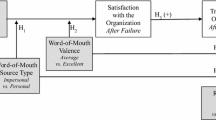Abstract
Adoption of self-service technologies (SSTs) is changing the current service landscape in many ways. However, most previous research focused on customer’s acceptance of such technologies, neglecting the consequences of technology adoption. In the current research, a specific behavioral consequence, negative word of mouth (NWOM) during SST failure is investigated. Through an experimental study, the effect of SST failure on customer’s NWOM intentions and the underlying mechanism of the relationship are demonstrated. Specifically, customers who have experienced SST failures were more likely to engage in NWOM because of the heightened regret felt at the moment, which is a specific negative emotion associated with self-blame. In addition, the moderated mediation effect of an individual difference, fear of negative evaluation is suggested to moderate the relationship between regret and NWOM intentions. Taken together, the current research highlights the role of a negative emotion during service failures.
Similar content being viewed by others
References
Alexandrov A, Lilly B, & Babakus E (2013) The effects of social-and self-motives on the intentions to share positive and negative word of mouth, Journal of the Academy of Marketing Science 41(5):531–546.
Anderson EW (1998) Customer satisfaction and word of mouth, Journal of Service Research 1(1):5–17.
Curran J & Meuter ML (2005) Self-service technology adoption: comparing three technologies, Journal of Services Marketing 19(2):103–113.
Day R & Landon EL (1977) Toward a theory of consumer complaining behavior In: Woodside AG, Sheth JN, Bennett P (ed) Consumer and industrial buying. Elsevier, North-Holland: 425–437.
Elliott KM, Meng J, & Hall MC (2008) Technology readiness and the likelihood to use selfservice technology: Chinese vs. American consumers, Marketing Management Journal 18(2):20–31.
Gavett G (2015) How self-service kiosks are changing customer behavior. https://hbr.org/ 2015/03/how-self-service-kiosks-are-changing-customer-behavior. Accessed 2016-02-01.
Halstead D (2002) Negative word of mouth: substitute for or supplement to consumer complaints? Journal of Consumer Satisfaction, Dissatisfaction and Complaining Behavior 15:1–12.
Hart CWL, Heskett JL, & Sasser WE. (1990) The profitable art of service recovery, Harvard Business Review 68:148–156.
Hayes AF (2012) PROCESS: A versatile computational tool for observed variable mediation, moderation, and conditional process modeling. http://www.afhayes.com/public/process 2012.pdf. Accessed 2016-01-10.
Herr PM, Frank RK, & Kim J (1991) Effects of word-of-mouth and product-attribute information on persuasion: an accessibility-diagnosticity perspective, Journal of Consumer Research 17(4):454–462.
IBM Self-service survey results (2007) http://www-03.ibm.com/products/retail/products/self/hd/customer/index.html. Accessed 2016-02-01.
Kahneman D & Miller DT (1986) Norm theory: comparing reality to its alternatives, Psychological Review 93(2):136–153.
Leary MR (1983) A brief version of the fear of negative evaluation scale, Personality and Social Psychology Bulletin 9(3):371–375.
Maxham JG (2001) Service recovery’s influence on consumer satisfaction, positive word-ofmouth, and purchase intentions, Journal of Business Research 54(1):11–24.
Meuter ML, Ostrom AL, Roundtree RI, & Bitner MJ (2000) Self-service technologies: understanding customer satisfaction with technology-based service encounters, Journal of Marketing 64(3):50–64.
Parasuraman A (2000) Technology Readiness Index (TRI): A multiple-item scale to measure readiness to embrace new technologies, Journal of Service Research 2(4):307–320.
Rayport JF & Sviokla JJ (1994) Managing in the marketspace, Harvard Business Review 72(6):141–150.
Richins ML (1983) Negative word-of-mouth by dissatisfied consumers: a pilot study, Journal of Marketing 47(1):68–78.
Sherman DK & Cohen GL (2006) The psychology of self-defense: self-affirmation theory In: Zanna MP (ed) Advances in Experimental Social Psychology. Academic Press, San Diego, CA 38:183–242.
Swanson SR & Kelley SW (2001) Service recovery attributions and word-of-mouth intentions, European Journal of Marketing 35(1/2):194–211.
Taylor SE (1991) Asymmetrical effects of positive and negative events: the mobilizationminimization hypothesis, Psychological Bulletin 110(1):67–85.
Watson D & Friend R (1969) Measurement of social-evaluative anxiety, Journal of Consulting and Clinical Psychology 33(4):448–457.
Wetzer IM, Zeelenberg M, & Pieters R (2007) ‘Never eat in that restaurant, I did!’: exploring why people engage in negative word-of-mouth communication, Psychology and Marketing 24(8):661–680.
Winton EC, Clark DM, & Edelmann RJ (1995) Social anxiety, fear of negative evaluation and the detection of negative emotion in others, Behaviour Research and Therapy 33(2): 193–196.
Zeelenberg M & Pieters R (2004) Beyond valence in customer dissatisfaction: a review and new findings on behavioral responses to regret and disappointment in failed services, Journal of Business Research 57(4):445–455.
Zeelenberg M, van Dijk WW, Manstead ASR, & van der Plight J (2000) On bad decisions and disconfirmed expectancies: the psychology of regret and disappointment, Cognition and Emotion 14(4):521–541.
Zeithaml V & Bitner MJ (2003) Services Marketing: Integrating customer focus across the firm. Mc-Graw-Hill, New York, NY.
Zhu Z, Nakata C, Sivakumar K, & Grewal D (2013) Fix it or leave it? Customer recovery from self-service technology failures, Journal of Retailing 89(1):15–29.
Author information
Authors and Affiliations
Corresponding author
Additional information
Seo Young Kim is a Doctoral Candidate in Marketing at Seoul National University. She holds a Master’s degree from Northwestern University, and a bachelor’s degree from the University of Illinois at Urbana Champaign. Her research interests include service marketing, customer helping behavior, and self-service technologies.
Rights and permissions
About this article
Cite this article
Kim, S.Y. Negative word of mouth intentions during self-service technology failures: The mediating role of regret. J Serv Sci Res 8, 41–55 (2016). https://doi.org/10.1007/s12927-016-0002-y
Received:
Accepted:
Published:
Issue Date:
DOI: https://doi.org/10.1007/s12927-016-0002-y




